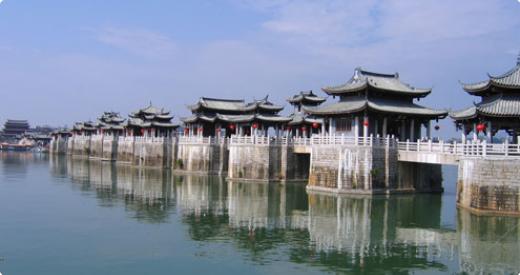
Population 2.6 million
Cuisine Chaozhou; north-central Chinese combined with Southeast Asian influences
Signature Dishes Chaozhou style steamed fish 潮州蒸鱼 (fresh fish steamed with tomatoes, salted plums, salted vegetables, chillis, ginger and green onions), Chaozhou style prawn roll 潮州蝦卷 (prawns wrapped in fried tofu skin), Chaozhou style oyster omelette 潮州蚵仔煎 (small oysters fried in an egg and potato starch batter), Chaozhou crab (steamed cold crab dipped in vinegar), Sugar Vinegar Noodles (pan-fried yellow noodles sprinkled with vinegar and sugar)
Wine Culture Developing wine market with good potential for growth
Wine Duty Approximately 48%
The Hanjiang River flows throughout the city of Chaozhou, making it a part of the “maritime Silk Road”, while the Golden, Silver and Hanshan Mountains surround it. Located in the easternmost part of Guangdong Province in the south of China, the cradle of Chaozhou culture is a famous cultural city with a history of over 1,600 years, and boasts over 1,300 heritage sites declared by the State Council of the People’s Republic of China. Its ancient city walls ring the city, first built in 1171 during the Song Dynasty, featuring 24 piers for eastern Guangdong’s busy water traffic.
Chaozhou is the birthplace of kungfu tea 工夫茶- literally “tea made with effort”. First recorded during the Song dysnasty in 440-470AD, the strong dark tea is served in tiny tea cups the size of Western shot glasses. Nicknamed the “espresso” of Chinese teas, the bitter tea requires high quality tea leaves and temperature control and renders a strong kick of caffeine that has become a regular feature of the local diet. Morever, it is an important part of social etiquette; during family visits or meals in restaurants, at least one round of kungfu tea is guaranteed.
Chaozhou also boasts the largest Buddhist temple in the Fujian province, Kaiyuan Temple, built during the reign of China’s only female Empress, Wu Zetian during 686AD. The temple features a Buddha in the central complex with the architecture from Chinese dynasties added on over the centuries decorating it. The Sutra Depository, a valuable collection of tens of thousands of sutra collected over thousands of years, and devout believers from all over China travel to visit it. Buddhist influence can be seen in Chaozhou’s many trademark vegetarian dishes, from the savoury fried white radish cake, stir fried white radish with rice flour in soysauce, eggs, garlic and spring onion to oyster omelette, small oysters mixed and fried in a batter of eggs and potato starch.
Chaozhou is a city of mixed Chinese cultures. The city’s native population are made up of two types: the local Chaozhou people indigenous to the area, and the later Hakka people. While the locals were originally seafarers who settled into the area, the Hakka came from northern China to escape the civil wars during the Qing dynasty from 1644 to 1912. This can be seen in Chaozhou’s cuisine, which bears similarities to Fujian’s delicate and tender flavours, little use of oil and emphasis on poaching, steaming and braising dishes. Uses of broths and soups are also popular in Teochew cooking, such as the special stock called “Superior broth”, a rich umami-laden broth made from Jinhua ham and chicken; as the popular local saying goes, “One broth [can be made into] ten forms” (湯十變).
Chaozhou’s municipal government has recently focused its economy towards creating a national historic, modern city by supporting major industries such as ceramics, garments, machinery hardware, pharmaceuticals, textiles and plastics. The Chaozhou 2012 Trade Fair further unveiled the implementation of 55 key projects, with a total investment of an estimated investment of more than 830 billion RMB, according to the Nanfang Daily News . The Chaozhou government website also reports that the city’s GDP in 2007 was 38.75 billion with private businesses forming 90% of it.
The growing independent businesses and government investment marks Chaozhou as one of southern China’s rising stars. But the city isn’t all about business. Chaozhou’s beautiful landscape of rolling hills and rivers, historical landmarks and unique cuisine will ensure that people will flock to Chaozhou to enjoy this city’s unique offerings.









